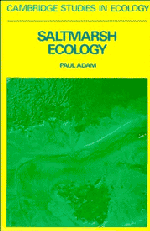Book contents
- Frontmatter
- Contents
- Preface
- Abbreviations for frequently-occurring species names
- 1 General features of saltmarshes and their environment
- 2 The saltmarsh biota
- 3 Variation in saltmarsh vegetation
- 4 Coping with the environment
- 5 Plant life history studies
- 6 Saltmarshes as ecosystems
- 7 Modification, management and conservation
- References
- Index
1 - General features of saltmarshes and their environment
Published online by Cambridge University Press: 04 April 2011
- Frontmatter
- Contents
- Preface
- Abbreviations for frequently-occurring species names
- 1 General features of saltmarshes and their environment
- 2 The saltmarsh biota
- 3 Variation in saltmarsh vegetation
- 4 Coping with the environment
- 5 Plant life history studies
- 6 Saltmarshes as ecosystems
- 7 Modification, management and conservation
- References
- Index
Summary
Introduction
Coastal saltmarshes may be defined as areas, vegetated by herbs, grasses or low shrubs, bordering saline water bodies. Although such areas are exposed to the air for the majority of the time, they are subjected to periodic flooding as a result of fluctuations (tidal or non-tidal) in the level of the adjacent water body.
Distinction is drawn between saltmarsh and two other vegetation types found in similar habitats. Seagrass beds are for the most part permanently submerged but in some localities are found on mud or sandflats exposed at low water during spring tide periods. The characteristic floristic composition and structure of these intertidal stands is sufficient to maintain a distinction from any areas conventionally regarded as saltmarsh. Mangroves differ from saltmarsh in being dominated by trees. Where mangroves are well developed, forming forests 30 m high, the distinction between mangrove and saltmarsh is clear. However, there are areas where the differences are less striking. In southern Australia, at the southern limit of mangrove distribution, Avicennia marina forms a low shrubland, which can be shorter in stature than Sclerostegia arbuscula on adjacent saltmarsh. In such cases the distinction is on the basis of floristics and convention. Avicennia, which at lower latitudes is a medium-sized tree, is regarded as always being a mangrove, while Sclerostegia is never accorded mangrove status and is conventionally accounted as a member of the saltmarsh flora.
- Type
- Chapter
- Information
- Saltmarsh Ecology , pp. 1 - 71Publisher: Cambridge University PressPrint publication year: 1990
- 1
- Cited by



